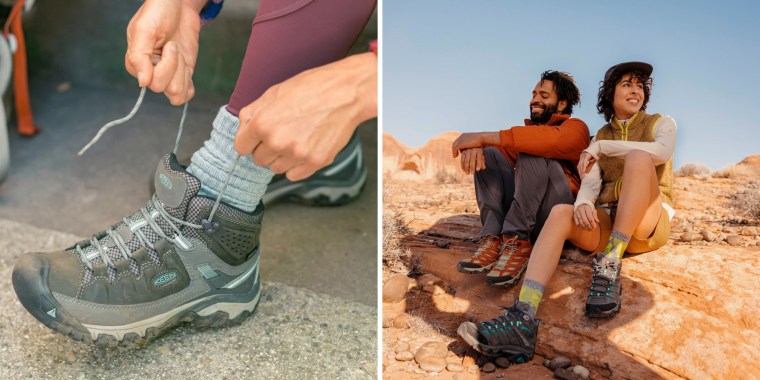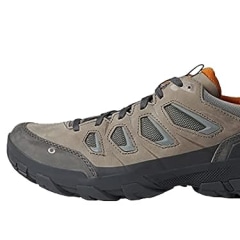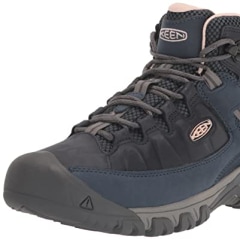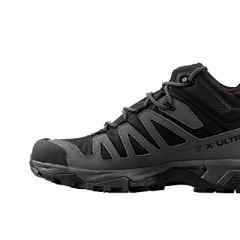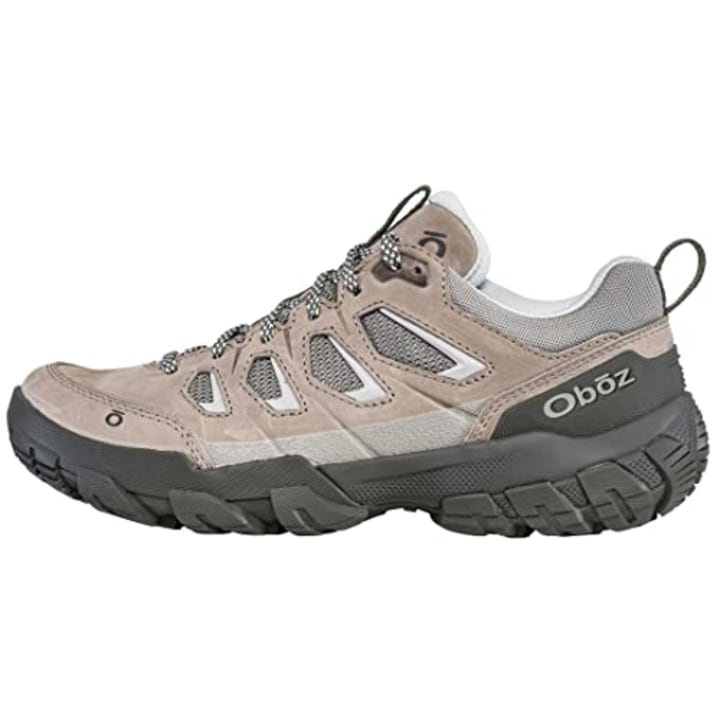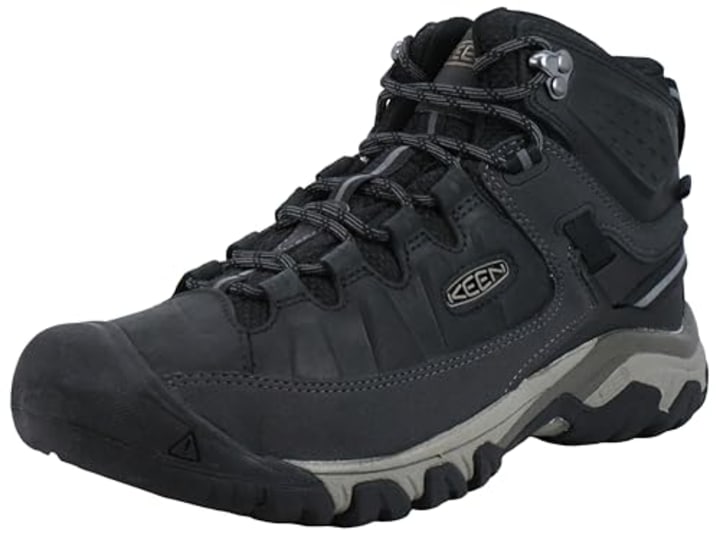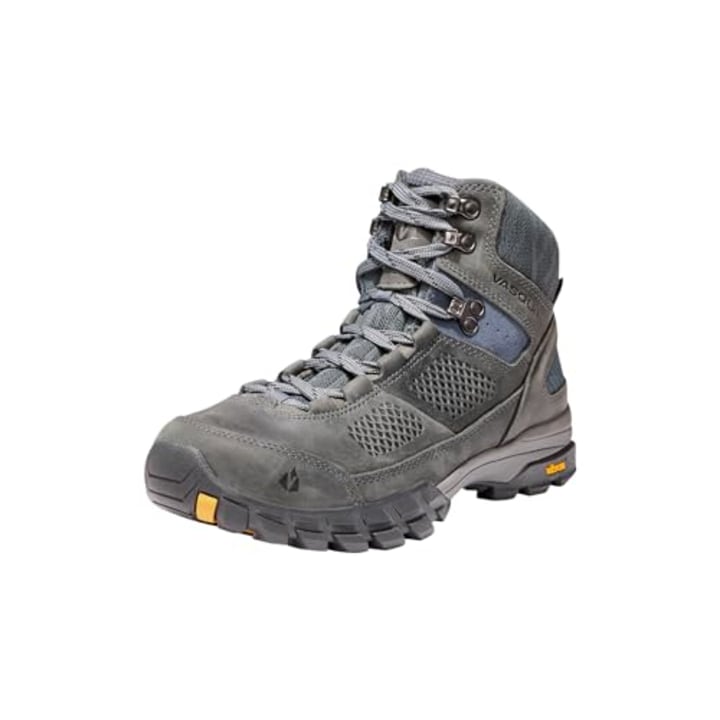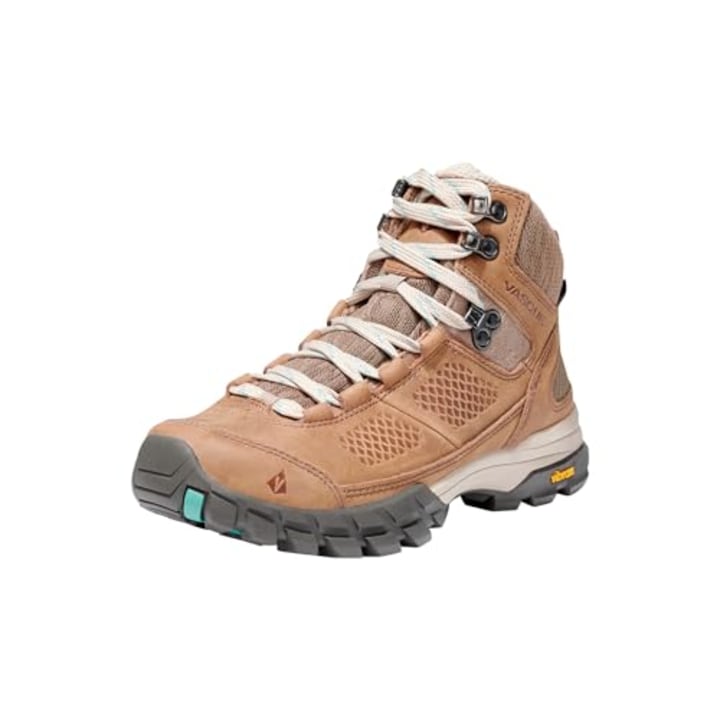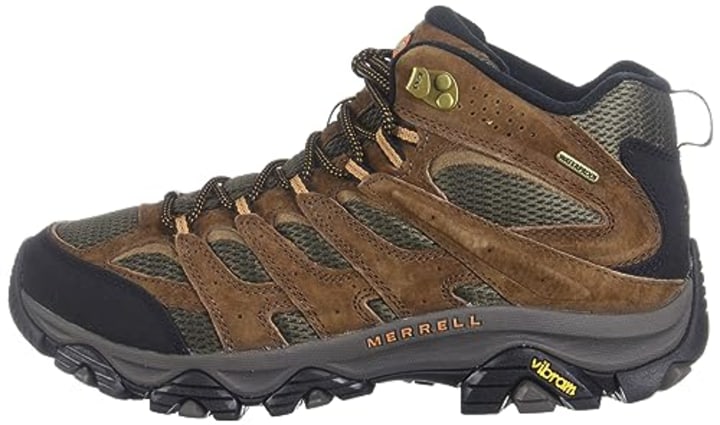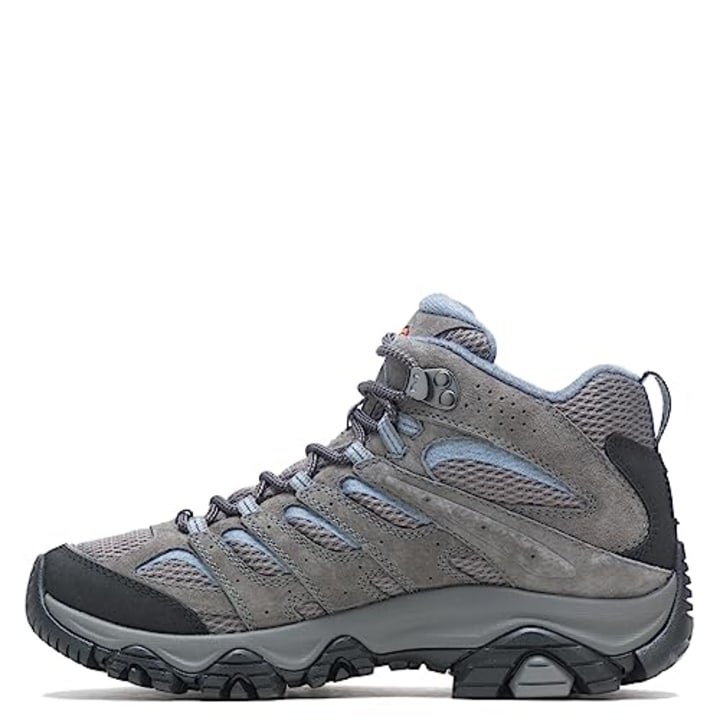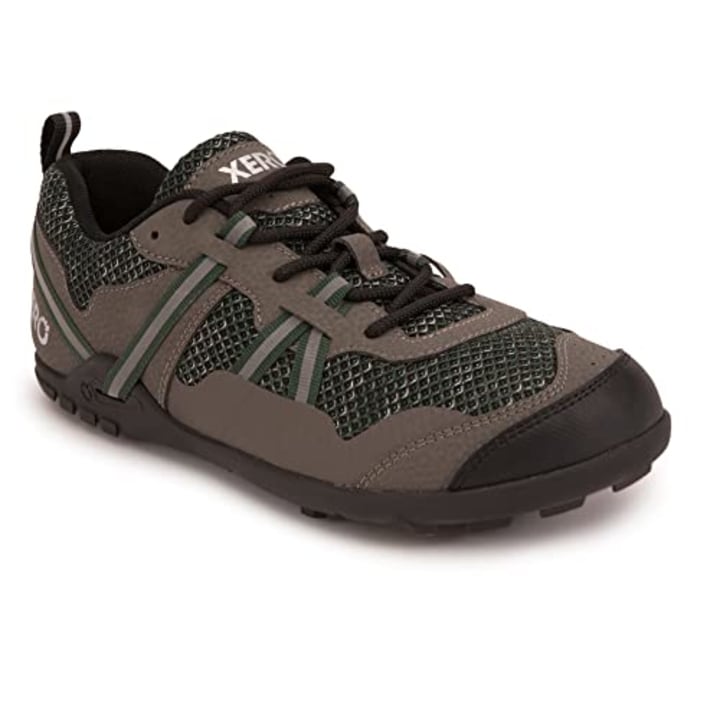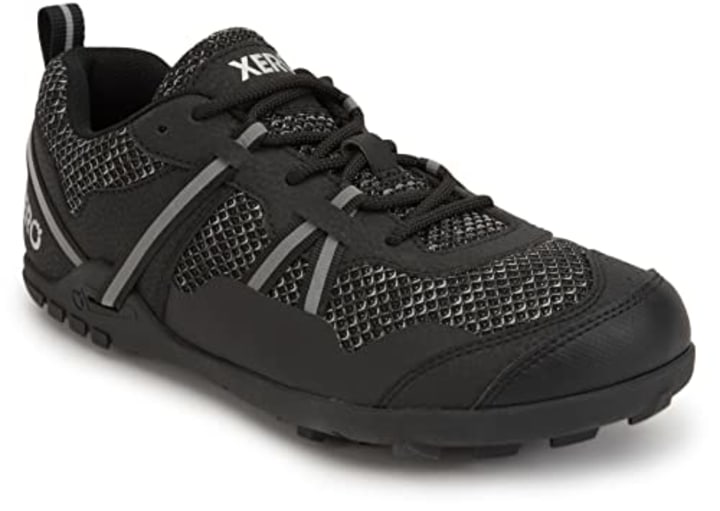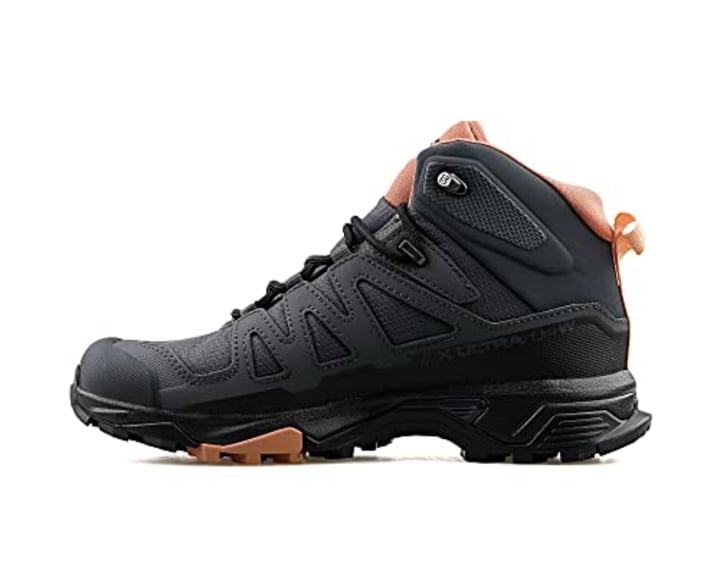Whether you are walking on local dirt paths or planning to complete the entire Appalachian Trail, you’ll need the right pair of shoes to have a comfortable hike. Hiking shoes and boots have more traction, support, protection and weather-resistance than everyday walking or running shoes.
Hiking footwear can be as diverse as the terrain you’ll tackle — some are more suited to cold, snowy exploration, while others are better for hot and dry climates. We spoke with outdoor experts to better understand what makes hiking shoes different from everyday sneakers and what to look for when shopping for a pair.
SKIP AHEAD Our favorite hiking shoes and boots of 2024 | Hiking boots versus hiking shoes | How to shop for hiking shoes and boots | Anatomy of a hiking shoe
How we picked the best hiking shoes and boots
We spoke with experts to better understand the different types of hiking footwear. Combining their advice with NBC Select staff experience, we chose shoes and boots using the following criteria:
- Size and fit: Getting the right fit is crucial for any hiking shoe or boot, according to our experts. We have options with inclusive size and width options.
- Style: Hiking footwear typically includes trail running shoes, hiking shoes and hiking boots. Each style has its pros and cons — we included a mix of hiking shoes and boots for different weather and terrain.
- Waterproofing: Most of our staff-recommendations have some level of weather-resistance to handle messy Northeast winters, where our team is located.
Our favorite hiking shoes and boots of 2024
Our top picks come from a mix of expert and staff-recommended brands like Merrell, Keen, Salomon and more. We included both hiking shoes and hiking boots, but not trail running shoes. Trail running shoes are lightweight, breathable and built for faster speeds — a different intent than hiking footwear, according to our experts. You can learn more about the differences in our guide to best trail running shoes.
Men’s Oboz Sawtooth X Low Waterproof Hiking Shoes
Women’s Oboz Sawtooth X Low Waterproof Hiking Shoes
Kevin Rosenberg, founder and lead guide of International Adventure Guides, a guided adventure touring company, has wide feet and favors brands with wide width options like Oboz. These shoes have a low cut similar to running shoes, meaning a lighter and more flexible feel based on my experience wearing other shoes with similar cuts.
The Sawtooth X has a new outsole compared to the previous model, with improved traction and an updated midsole for a smoother landing, according to the brand. They have fabric loops on the tongue and the heel to make pulling them on and taking them off easier. These shoes are waterproof but not lined: cold-weather hikers should consider a more insulated option.
Sizes offered: 7-15 men’s, 5-12 women’s, including half sizes | Widths offered: Medium, wide | Weight: 16.9 oz men’s, 14.1 oz women’s | Waterproof: Yes
Men’s Keen Targhee III Mid Waterproof Hiking Boots
Women’s Keen Targhee III Mid Waterproof Hiking Boots
NBC page Hannah Fuechtman has had her Keen Targhee boots for eight years, and calls them her “emotional support boots.” She has used them for local summer and winter hikes on paved trails and rocky surfaces with dirt and gravel, as well as on hikes in Glacier National Park and the Rocky Mountains in the rain and snow. Her feet stayed dry through them all.
Fuechtman prefers a more supportive shoe to combat her frequent knee pain and finds these boots very comfortable. They have a high-top style with more ankle support than lower-cut shoes.
For added ankle support, Fuechtman loops the laces around the eyelets all the way to the top of the boot to help keep her foot secure.
Compared to its predecessor, the Targhee III is lighter by a little over an ounce, and has more cushioning in the midsole, according to the brand. The boot is made with a leather and mesh upper, EVA (ethyl vinyl acetate) midsole and rubber outsole.
Sizes offered: 7-17 men’s, 5-11 women’s, including most half sizes | Widths offered: N/A | Weight: 17.11 oz men’s, 14.46 oz women’s | Waterproof: Yes
Men’s Vasque Talus All-Terrain UltraDry Hiking Boot
Women’s Vasque Talus All-Terrain UltraDry Hiking Boot
Rosenberg also wears and recommends Vasque. Like the Keen Targhee, these shoes are made with a leather and mesh upper and rugged rubber outsole. The lugs on the outsole cover the entire bottom of the shoe and wrap slightly around the front of the shoe for extra grip, according to the brand. It is also another brand that makes shoes with multiple widths — this boot comes in medium and wide sizing.
This boot has three pairs of hooked eyelets on the upper — most of our other boot recommendations only have one pair. Hooked eyelets are great for lacing your boots extra-tight and bolstering ankle support based on my experience using other hooked eyelets.
These are the heaviest boots on our list. If you are looking for something lighter, the brand offers these boots as a low-cut shoe version in men’s and women’s sizes.
Sizes offered: 7-14 men’s, 6-11 women’s, including most half sizes | Widths offered: Medium, Wide | Weight: 17.5 oz men’s, 14.7 oz women’s | Waterproof: Yes
Men’s Merrell Moab 3 Mid Waterproof Hiking Boots
Women’s Merrell Moab 3 Mid Waterproof Hiking Boots
NBC Select production coordinator Kelsey Fredricks has had her Moab boots for five years, wearing them on winter trails in Ireland and year-round treks in the Hudson Valley in New York. She has also used them as rain boots in a pinch. “Whenever I decide to go hiking, I know I have these boots as my trusted sidekick,” she says.
Fredricks overpronates (her foot rolls inward) when she walks and runs and has narrow or medium-width feet, depending on the brand. The outsole provides great traction, plus the footbed is wide, which makes them very comfortable, according to Fredricks.
These boots keep her feet dry and warm, even after hours of trekking in 1 to 2-inches of snow on mountainous hikes in Ireland. Fredricks says she feels stable and confident tackling muddy and wet trails in these boots. “I can be kind of clumsy sometimes and I feel like these boots hold me up right.”
The Moab 3 boot is made with a leather and mesh upper, rubber outsole, and a more cushioned midsole than the previous version, according to the brand.
Sizes offered: 7-16 men’s, 5-12 women’s, including half sizes | Widths offered: Medium, wide | Weight: 16.36 oz | Waterproof: Yes
Men’s Xero Shoes TerraFlex II
Women’s Xero Shoes TerraFlex II
Steve Frank, a volunteer instructor at the Colorado Mountain Club backpacking school, loves these minimal, barefoot-style hiking shoes. They are lightweight (the lightest shoe on our list), breathable and flexible, says Frank. “It’s almost like having nothing on your feet.”
Barefoot-style shoes are designed to engage your entire foot and better connect your feet to the terrain you’re tackling, according to the brand. But they aren’t for everyone — the shoes have a flat footbed, little cushion and minimal ankle stability, says Frank. He recommends building your balance and foot strength before wearing barefoot-style shoes like these full-time.
Frank uses the Terraflex shoe (linked above) for day hikes and the Xero Scrambler Mid shoe for backpacking.
Sizes offered: 6.5-15 men’s, 5-12 women’s, including most half sizes | Widths offered: N/A | Weight: 9.6 oz men’s, 8.3 oz women’s | Waterproof: No
Men’s Salomon X Ultra 4 Mid GTX Hiking Boots
Women’s Salomon X Ultra 4 Mid GTX Hiking Boots
After years of hiking trails in running shoes, I decided to buy a pair of hiking boots for days spent outside in the cold weather. I tend to favor a neutral, medium width, cushioned shoe that does not alter my mostly straight gait, but can still help prevent knee aches.
The first thing I noticed using these boots was improved traction. I would often slip in my running shoes when tackling steep inclines or rocky scrambles — these reduced my slips and slides to almost zero.
Despite how much larger they are than regular shoes, at 14.99 and 13.05 ounces respectively, these are the lightest mens and womens’ boots on our list.
They are also very warm — I hiked in 36 degree weather and did not get cold feet, even after about four hours of hiking with a windy alpine section. When the temperature hits 70 degrees or above, I find these shoes too warm, and use my trail running shoes instead.
It is easy to tie these boots tightly all the way up to the ankle, looping the laces around the eyelets, adding extra support for more rocky, technical terrain. They are also easy to take on and off with because of the flexible tongue and fabric loop on the back of the heel.
These boots are made with a coated leather and textile upper, rubber outsole and lined, cushioned midsole, according to the brand.
Sizes offered: 7-14 men’s, 5-11 women’s, including half sizes | Widths offered: Medium, wide | Weight: 14.99 oz men’s, 13.05 oz women’s | Waterproof: Yes
Hiking boots versus hiking shoes
Hiking shoes are generally low-cut like running shoes, but provide more ankle support and keep your foot more firmly in place to help you avoid ankle twists and other potential injuries, says Maggie Peikon, the manager of communications at the American Hiking Society, a Maryland-based nonprofit dedicated to preserving trails and the hiking experience.
Hiking boots are typically heavier than hiking shoes, but they tend to have more ankle support, says Rosenberg. In wet climates, they typically keep your feet drier and warmer than a hiking shoe, according to our experts.
How to shop for hiking shoes and boots
Experts recommend considering the type of hike you’re planning, the weight of your shoe and the tread of the outsole when shopping for hiking footwear. But the process for finding the right shoe isn’t as straightforward as it seems. Below are a few tips to keep in mind when shopping.
Size and fit
Your foot is a bit larger at the end of the day than in the morning, says Peikon. Trying on shoes at the end of the day can help you find a better fit, as your feet will similarly be a little larger when you are hiking.
It’s best to feel secure while wearing your hiking shoe or boot — your heel and toes shouldn’t be slipping and sliding around with each step, says Peikon. At the same time, footwear shouldn’t be too tight — your toes shouldn’t be touching the front of the shoe, for example.
When trying a new shoe, wear the socks you plan to hike in — sock thickness can change how a shoe fits and feels, in my experience.
Some hiking boots need break-in time, but how they fit in the short-term is usually how they will fit after a few weeks of use, says Rosenberg. If they don’t feel comfortable at the start, they won’t suddenly feel comfortable later on.
You can go to your local outdoors shop to try on different boots and get advice from experienced staff. This has helped me find the perfect fit when shopping for any kind of outdoor or sport shoe.
Ankle support
The stiffness of your shoe can help protect you from accidental rolls and slips that can injure your ankles — a stiffer shoe is more stable than one that flexes easily, according to the Appalachian Mountain Club, the U.S.’ oldest conservation and recreation organization. Try grabbing the shoe at the front and back and twisting it side-to-side — the harder it is to twist, the more stable it will be, according to the organization.
How high your shoe is can also play a factor in ankle support and stability. Hiking boots will usually have a more stable, stiffer sole, while hiking shoes and trail runners will be lighter and faster to walk (or run) with, in my experience. For most hikes, a mid-height shoe or boot is appropriate, says Rosenberg. For long-distance hikes carrying a heavy pack, however, you may want to look into a full-height boot.
Terrain
The type of hike — and the weather conditions that come with it — can determine your priorities when thinking about which footwear to buy.
For hiking in dry, hot environments, Peikon prefers trail running shoes, as they tend to be the most breathable.
For rugged, uneven terrain that has sharp rocks or plants on the path, hiking boots can provide more support and protection — they sit highest on the ankle.
Hiking boots are also typically the warmest and most weather-resistant, according to our experts.
Water-resistance
Most of our staff picks have some amount of water-resistant fabrics or treatments. This is great if you live in a rainy, damp or cold-climate with changing conditions, says Peikon.
If you are going on a multi-day (or week) adventure in warmer climates, however, consider a breathable, non-waterproof shoe, says Matthew Rowbotham, the program manager of geographic information systems at North Country Trail Association. Sweat and water will evaporate faster with a well-ventilated, non-waterproof shoe than a fully-weatherized boot.
Anatomy of a hiking shoe
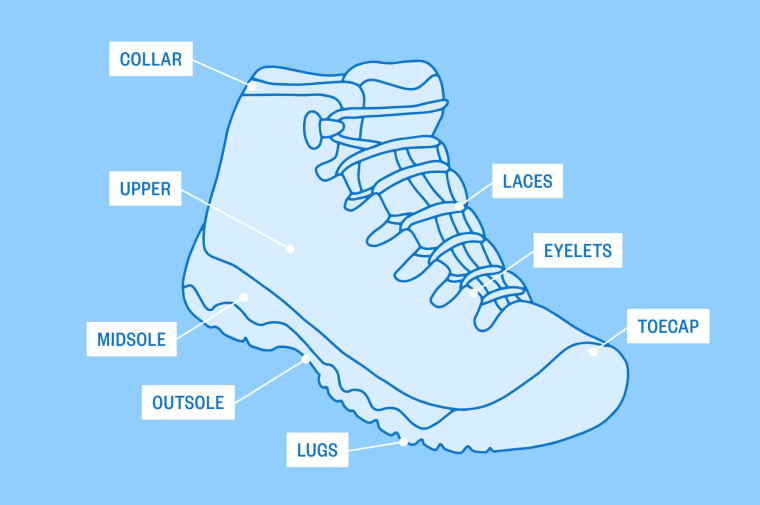
The outsole is the bottom part of the hiking shoe that makes contact with the ground. It is usually made of rubber that will easily grip onto surfaces. The outsole also typically features lugs, indentations or grooves that add grip and traction when walking through rocks or rough surfaces.
The midsole, located inside of the shoe between the outsole and the upper, is one of the most important elements for cushioning and protecting your feet from the terrain. A midsole is typically made from ethylene vinyl acetate (EVA), which is soft and common in most trail or light hiking shoes, or polyurethane (PU), a more durable, heavier option that’s common in heavy-duty backpacking and mountaineering boots that can have a break-in period, according to our experts.
The upper is what covers and protects most of your foot and ankle, it makes up most of the top part of a shoe. The material of the upper affects how breathable, weather-resistant, insulated and heavy the shoe is, according to our experts.
Meet our experts
At NBC Select, we work with experts who have specialized knowledge and authority based on relevant training and/or experience. We also take steps to ensure all expert advice and recommendations are made independently and without undisclosed financial conflicts of interest.
- Kevin Rosenberg is the owner and lead guide of International Adventure Guides, a guided adventure touring company that leads group travel to destinations in Norway, Greenland, Iceland and more.
- Steve Frank is a volunteer instructor at the Colorado Mountain Club, an outdoor education nonprofit based in Colorado since 1912. He teaches at its backpacking school and has more than a decade of backpacking experience.
- Maggie Peikon is the manager of communications at the American Hiking Society, a Maryland-based nonprofit dedicated to preserving trails and the hiking experience.
- Matthew Rowbotham is the program manager of geographic information systems at North Country Trail Association, a nonprofit that partners with the national park service to develop, maintain and protect the 4,800 mile North Country Trail.
Why trust NBC Select?
Harry Rabinowitz is a reporter at NBC Select who covers technology and fitness, including recent stories on running shoes, fitness trackers and workout earbuds. For this piece, he interviewed outdoor experts to get a better understanding of hiking footwear. He combined his experience and the experience of the NBC Select team using hiking shoes and boots over the years.
Catch up on Select’s in-depth coverage of personal finance, tech and tools, wellness and more, and follow us on Facebook, Instagram, Twitter and TikTok to stay up to date.
